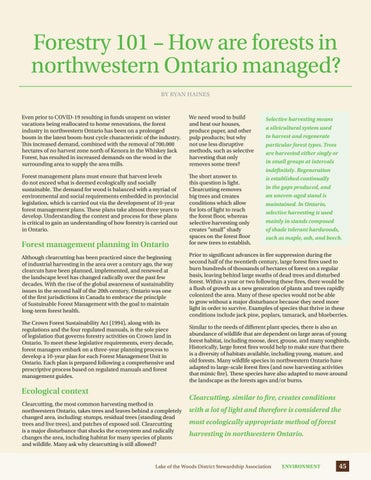Forestry 101 – How are forests in northwestern Ontario managed? BY RYAN HAINES
Even prior to COVID-19 resulting in funds unspent on winter vacations being reallocated to home renovations, the forest industry in northwestern Ontario has been on a prolonged boom in the latest boom-bust cycle characteristic of the industry. This increased demand, combined with the removal of 700,000 hectares of no harvest zone north of Kenora in the Whiskey Jack Forest, has resulted in increased demands on the wood in the surrounding area to supply the area mills.
We need wood to build and heat our houses, produce paper, and other pulp products; but why not use less disruptive methods, such as selective harvesting that only removes some trees?
Forest management plans must ensure that harvest levels do not exceed what is deemed ecologically and socially sustainable. The demand for wood is balanced with a myriad of environmental and social requirements embedded in provincial legislation, which is carried out via the development of 10-year forest management plans. These plans take almost three years to develop. Understanding the context and process for these plans is critical to gain an understanding of how forestry is carried out in Ontario.
The short answer to this question is light. Clearcutting removes big trees and creates conditions which allow for lots of light to reach the forest floor, whereas selective harvesting only creates “small” shady spaces on the forest floor for new trees to establish.
Forest management planning in Ontario Although clearcutting has been practiced since the beginning of industrial harvesting in the area over a century ago, the way clearcuts have been planned, implemented, and renewed at the landscape level has changed radically over the past few decades. With the rise of the global awareness of sustainability issues in the second half of the 20th century, Ontario was one of the first jurisdictions in Canada to embrace the principle of Sustainable Forest Management with the goal to maintain long-term forest health. The Crown Forest Sustainability Act (1994), along with its regulations and the four regulated manuals, is the sole piece of legislation that governs forestry activities on Crown land in Ontario. To meet these legislative requirements, every decade, forest managers embark on a three-year planning process to develop a 10-year plan for each Forest Management Unit in Ontario. Each plan is prepared following a comprehensive and prescriptive process based on regulated manuals and forest management guides.
Ecological context Clearcutting, the most common harvesting method in northwestern Ontario, takes trees and leaves behind a completely changed area, including: stumps, residual trees (standing dead trees and live trees), and patches of exposed soil. Clearcutting is a major disturbance that shocks the ecosystem and radically changes the area, including habitat for many species of plants and wildlife. Many ask why clearcutting is still allowed?
Selective harvesting means a silvicultural system used to harvest and regenerate particular forest types. Trees are harvested either singly or in small groups at intervals indefinitely. Regeneration is established continually in the gaps produced, and an uneven-aged stand is maintained. In Ontario, selective harvesting is used mainly in stands composed of shade tolerant hardwoods, such as maple, ash, and beech.
Prior to significant advances in fire suppression during the second half of the twentieth century, large forest fires used to burn hundreds of thousands of hectares of forest on a regular basis, leaving behind large swaths of dead trees and disturbed forest. Within a year or two following these fires, there would be a flush of growth as a new generation of plants and trees rapidly colonized the area. Many of these species would not be able to grow without a major disturbance because they need more light in order to survive. Examples of species that thrive in these conditions include jack pine, poplars, tamarack, and blueberries. Similar to the needs of different plant species, there is also an abundance of wildlife that are dependent on large areas of young forest habitat, including moose, deer, grouse, and many songbirds. Historically, large forest fires would help to make sure that there is a diversity of habitats available, including young, mature, and old forests. Many wildlife species in northwestern Ontario have adapted to large-scale forest fires (and now harvesting activities that mimic fire). These species have also adapted to move around the landscape as the forests ages and/or burns.
Clearcutting, similar to fire, creates conditions with a lot of light and therefore is considered the most ecologically appropriate method of forest harvesting in northwestern Ontario.
Lake of the Woods District Stewardship Association Environment
45
























